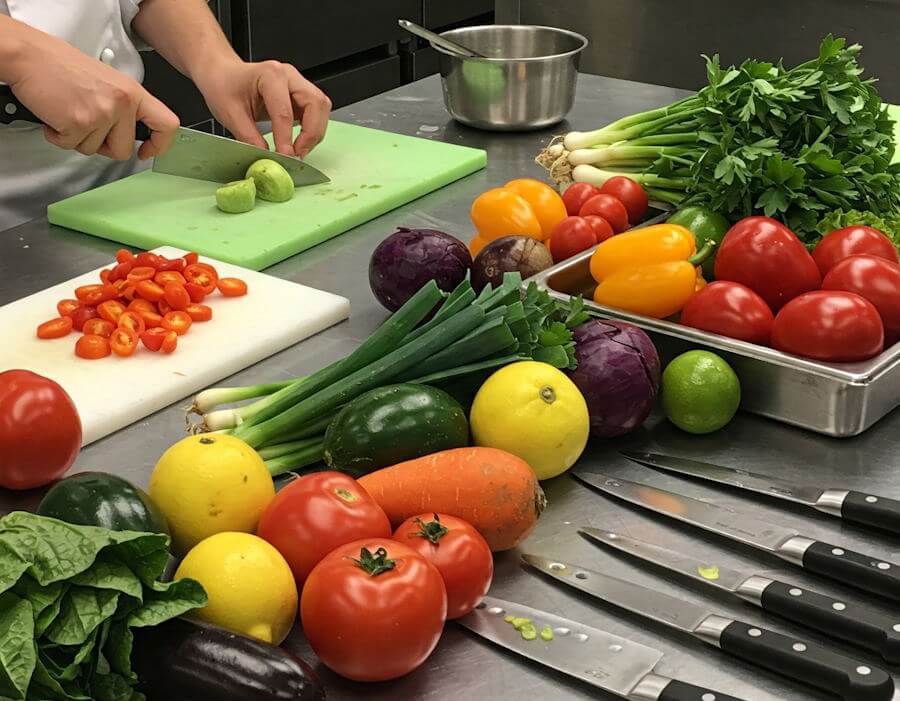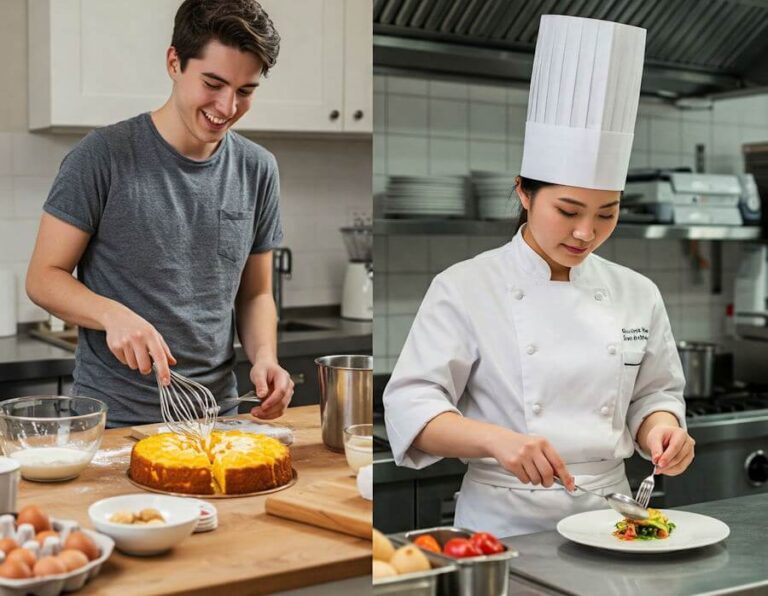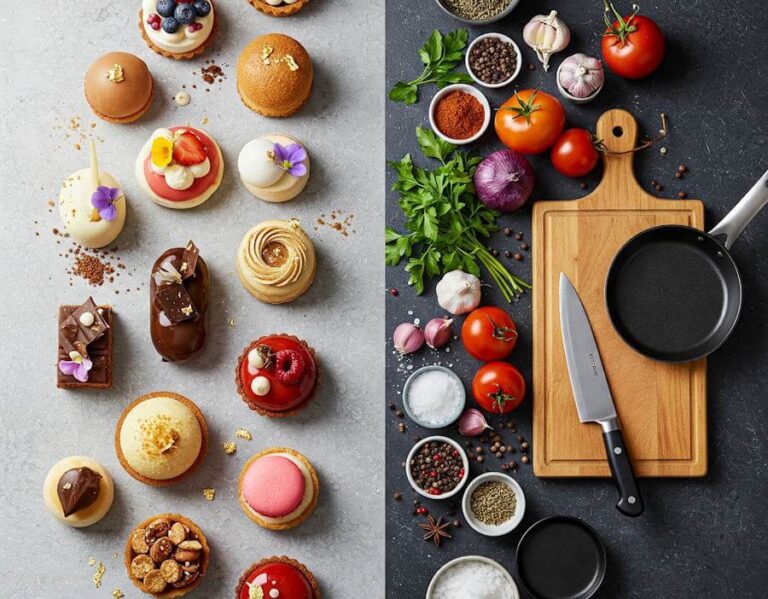In the realm of culinary arts, knife skills serve as a cornerstone for aspiring chefs and culinary students alike. Mastering the various techniques associated with handling knives not only improves efficiency in the kitchen but also plays a crucial role in ensuring safety and precision during food preparation. A well-honed knife skill set empowers culinary students to navigate through a multitude of tasks, from basic cutting to more intricate food presentation. As such, it signifies an essential element of their culinary education.
The importance of knife skills cannot be overstated. Proper knife techniques reduce the likelihood of accidents, enabling students to work with greater confidence and control. Utilizing the correct grip, angle, and motion facilitates smoother cuts, while understanding the use of different types of knives allows for versatility in handling various ingredients. This knowledge is critical for students as they progress through their culinary training, providing a strong foundation on which they can build more advanced skills.
Furthermore, mastering knife skills enhances both speed and efficiency in the kitchen—key attributes in a professional culinary environment where time is often of the essence. With the ability to produce even, consistent cuts, culinary students can streamline their workflow, ultimately improving their overall productivity. This mastery also has a direct impact on the aesthetics of the dishes they create, as precision in cutting contributes to the visual appeal of plated foods.
In essence, good knife skills equip culinary students with the foundational expertise required in their future endeavors as chefs. By investing time and effort into perfecting these techniques, they lay the groundwork for a successful career in the culinary industry. Ultimately, embracing the importance of knife skills will not only enhance their culinary repertoire but also foster their growth as culinary professionals.
Types of Knives Every Culinary Student Should Have
In the world of culinary arts, having the right tools is fundamental to achieving proficiency in the kitchen. Among these tools, knives hold a significant position due to their versatility and necessity in food preparation. For culinary students, familiarizing themselves with various types of knives is crucial, as each knife serves a specific function that can enhance their cooking skills.
The chef’s knife is arguably the most essential knife in a culinary student’s arsenal. Typically ranging from 8 to 10 inches in length, this multi-purpose knife is designed for a variety of tasks including chopping, slicing, and dicing. Its broad blade enables ease in handling various ingredients, making it a beloved choice for both seasoned chefs and culinary novices.
Next, we have the paring knife, which is significantly smaller, usually measuring 3 to 4 inches. This knife is ideal for intricate tasks such as peeling fruits and vegetables, deveining shrimp, or making precise cuts. Its maneuverability makes it invaluable for detailed work where accuracy is critical.
The serrated knife, often used for slicing bread, has a scalloped edge that effortlessly cuts through crusts while maintaining the integrity of softer insides. This type of knife is essential for culinary students who frequently work with baked goods or tomatoes, where a clean slice is necessary without crushing the product.
Other notable knives to consider include the boning knife, which is specifically designed to remove bones from meats and fish, and the fillet knife, which allows for delicate cuts needed for fish preparation. Understanding the distinctions among these knives empowers culinary students to select the appropriate tools for each task they encounter in the kitchen.
How to Properly Hold a Knife
Proper knife handling is an essential skill for anyone in the culinary field. A correct grip not only allows for better control but also enhances safety while working with sharp tools. There are several grip styles that culinary students should master, each serving a distinct purpose in effective knife use.
The pinch grip is widely regarded as the most effective method. In this technique, the thumb and the index finger pinch the blade just above the handle, while the remaining fingers wrap comfortably around the handle. This grip provides exceptional control, as it allows the chef to maneuver the knife with precision, making it ideal for chopping, dicing, and slicing.
Alternatively, the handle grip is another common method, especially for less experienced cooks. In this style, the entire hand covers the handle, with fingers extended for support. Though safer for beginners who may not yet have the confidence or skill to use the pinch grip, this style can often lead to less precision in cutting.
Whichever grip is chosen, ensuring comfort and stability is paramount. Culinary students must pay attention to their hand positioning, adjusting their hold based on the size and weight of the knife. It is advisable to practice cutting with both grip styles to determine which one feels more natural.
To enhance knife-holding skills, one can engage in simple exercises like slicing vegetables while deliberately focusing on grip technique. Practicing with a partner can also offer constructive feedback on hand positioning and grip security. Ultimately, mastering how to hold a knife properly forms the foundation for efficient cooking and sets the stage for advanced knife skills in the culinary arts.
Essential Cutting Techniques
Mastering essential cutting techniques is fundamental to developing proficiency in any culinary environment. Among the most crucial techniques are slicing, dicing, mincing, and chiffonade. Each technique serves a specific purpose in food preparation and contributes to the overall presentation and texture of dishes.
Slicing involves cutting ingredients into thin, uniform pieces, which is vital for achieving even cooking and enhancing flavor distribution. To slice effectively, hold the knife at a slight angle and use a smooth, gliding motion. Vegetables such as bell peppers or onions are commonly sliced for salads or sautés, making this technique invaluable in a chef’s repertoire.
On the other hand, dicing yields uniform cubes of ingredients that are essential for recipes requiring consistent cooking times. To dice an ingredient, begin by slicing it into strips and then cross-cutting those strips to create cubes. This technique is typically used for vegetables like carrots or potatoes, ensuring they cook evenly in stews or stir-fries.
Mincing is used primarily with herbs and garlic for incorporating robust flavors into dishes. To achieve a fine mince, chop the ingredient repeatedly until it reaches the desired consistency. This technique is often applied to fresh herbs in sauces or marinades, enhancing the overall taste profile of culinary creations.
Chiffonade is a technique that involves stacking, rolling, and then slicing leafy vegetables or herbs into thin ribbons. This cutting method is commonly used for basil or spinach and adds a decorative touch to dishes while ensuring the flavors are well-distributed. By mastering the chiffonade technique, culinary students can elevate their plating and presentation skills.
Integrating these essential cutting techniques into everyday practice will not only sharpen a culinary student’s skills but also enhance their overall efficiency and creativity in the kitchen. Engaging in exercises that focus on these methods, along with recipe applications, will solidify their understanding and application.
Knife Safety and Maintenance
Knife safety is paramount in any kitchen environment, particularly for culinary students who are honing their skills. Being knowledgeable about best practices can significantly reduce the risk of accidents. First and foremost, one must always be mindful of their surroundings while using a knife. It is essential to maintain focus and avoid distractions, as even a momentary lapse in attention can lead to injury. Additionally, it is advisable to keep the cutting area free from clutter and to ensure that others maintain a safe distance during knife handling.
Using the appropriate knife for the task is another crucial safety aspect. Each knife is designed for specific uses, and employing the correct tool not only makes preparation easier but also minimizes the likelihood of accidents. For instance, using a chef’s knife for chopping vegetables is far safer than using a paring knife, which could slip and cause injury. Always store knives in a designated space, such as a knife block or magnet strip, to prevent unintentional contact when reaching for them.
In addition to ensuring that safety protocols are followed, it is vital to maintain and care for knives properly. Regularly honing the blade not only keeps it sharp but also reduces the effort required during food preparation, which enhances safety. It is advisable to avoid placing knives in a dishwasher, as the harsh conditions can deteriorate the blade and handle over time. Instead, hand-washing knives with warm soapy water and drying them immediately can prolong their life. Furthermore, maintaining the cutting edge through professional sharpening when necessary ensures effectiveness in the kitchen.
Prioritizing knife safety and maintenance creates a secure and efficient working environment for culinary students. By adopting these practices, they can develop essential skills while reducing the likelihood of accidents, all while ensuring the longevity of their tools.
Understanding Knife Cuts and Sizes
Knife skills are essential for any culinary student, as the type and size of each cut significantly influence cooking time, flavor development, and presentation. Mastering various knife cuts is crucial for producing uniform pieces that cook evenly, enhancing the overall quality of the dish. Among the most common knife cuts are julienne, brunoise, and batonnet, each serving a specific purpose in the kitchen.
The julienne cut involves creating long, thin strips that resemble matchsticks. This technique is particularly useful for vegetables like carrots and bell peppers, where a fine texture can enhance the dish’s visual appeal and ensure quick cooking. The uniformity of the julienne cut not only aids in even cooking but also adds elegance to salad presentations and stir-fry dishes.
On the other hand, the batonnet cut produces thicker sticks, approximately a quarter of an inch wide and two to three inches long. This cut is often used for root vegetables destined for roasting or blanching. The batonnet cut provides a hearty texture that holds up well during cooking, making it ideal for dishes that require a more substantial bite.
The brunoise cut takes the julienne technique one step further by dicing the julienne strips into tiny cubes, typically around one-eighth of an inch. This small, uniform size is perfect for sauces, soups, or garnishes, where the delicate shape contributes to a refined presentation and allows for a quicker infusion of flavors. Incorporating the brunoise cut adds sophistication to dishes and highlights a chef’s proficiency.
Understanding these various knife cuts is essential not only for efficiency but also for aesthetic presentation. The impact of cut size on cooking time is significant; smaller pieces cook faster while larger pieces remain intact longer. As culinary students practice these techniques, they will enhance their overall knife skills and improve their culinary creations.
Common Mistakes to Avoid with Knife Skills
Developing proficient knife skills is crucial for any culinary student, yet many encounter common pitfalls that impede their progress. One significant mistake is using an improper cutting angle while slicing, dicing, or chopping. For instance, cutting vegetables with an inappropriate angle can lead to uneven pieces and increase preparation time. To correct this error, students should focus on mastering the 20- to 30-degree angle for most cutting tasks, ensuring a clean and efficient cut that enhances presentation and cooking times.
Another frequent misstep is the selection of the wrong knife for a particular task. Culinary students may gravitate towards larger knives for precision tasks like peeling or coring, which can result in diminished control and increased risk of accidents. Each knife possesses a specific design tailored for certain tasks; for example, a paring knife is ideal for intricate work, while a chef’s knife excels in general preparation. Understanding the purpose of each knife will not only enhance efficiency but also improve safety during food preparation.
Hygiene practices are also critical in the kitchen, yet often overlooked. Failing to maintain cleanliness can lead to cross-contamination, posing health risks. Students should always ensure that knives are thoroughly cleaned after each use, particularly when switching between raw meats and vegetables. Additionally, it is essential to handle knives with care—to avoid accidents, students should use a secure cutting board, keep their hands dry, and always cut away from their bodies. Observing these hygiene practices will contribute to a safer cooking environment and promote professional standards in culinary arts.
In conclusion, being aware of these common knife skills pitfalls can greatly enhance a culinary student’s efficiency and safety in the kitchen. By practicing the correct cutting angles, using the appropriate knife for each task, and adopting rigorous hygiene practices, students can significantly improve their knife handling abilities.
Practicing Your Knife Skills
Developing proficient knife skills is essential for every culinary student, and regular practice is imperative to mastering these techniques. Engaging in practical exercises and activities outside the classroom can significantly enhance your cutting abilities. Here are some effective methods to incorporate into your routine.
One of the most straightforward ways to practice is by undertaking various kitchen tasks that require different cutting techniques. For instance, try preparing a mirepoix, which consists of finely chopping onions, carrots, and celery. This not only allows you to refine your dicing skills but also helps you become accustomed to using proper hand positioning and knife grip. Similarly, practice julienning bell peppers or chiffonading basil to explore different cutting styles.
Another effective approach is to set up practice drills for specific cutting techniques. Create a schedule that emphasizes one skill per session, such as honing your slicing or mincing techniques. For example, spend a day solely practicing how to mince garlic or slice tomatoes with precision. Utilizing a variety of fruits and vegetables can make the experience both enjoyable and educational. Avocados, for instance, are excellent for practicing your cutting proficiency as they require careful handling to achieve smooth, consistent results.
Additionally, setting personal challenges can track your progress and keep you motivated. You might challenge yourself to a timed exercise, where you aim to cut a set amount of vegetables within a specified timeframe while maintaining accuracy and safety. This not only sharpens your skills but also helps simulate the pressures of a professional kitchen environment.
In summary, combining practical kitchen tasks, dedicated practice drills, and personal challenges will significantly enhance your knife skills. The key is consistency and a willingness to experiment with different cutting techniques to foster improvement over time.
Conclusion and Next Steps
In sum, knife skills are foundational for any aspiring culinary professional. Proficiency in these skills enhances not just efficiency in the kitchen, but also greatly impacts the presentation and flavor of dishes. Throughout this blog post, we have examined various essential knife techniques, including proper grip, slicing, dicing, and the importance of maintaining a sharp blade. Mastery of these skills allows culinary students to work with precision and creativity, contributing to their overall success in the culinary arts.
As you continue on your culinary journey, remember that developing your knife skills is an ongoing process. Regular practice will lead to improved dexterity, which is vital for any chef. Furthermore, it is important to cultivate a safe working environment by adhering to safety protocols while using knives, as this knowledge is just as crucial as technical prowess.
To further enhance your knife skills, consider enrolling in specialized culinary courses that focus on knife techniques. Many culinary schools offer workshops where you can receive hands-on training from experienced chefs. Additionally, there is a wealth of online resources available, such as video tutorials and interactive platforms, that can guide you through various knife techniques at your own pace. Books authored by renowned chefs often contain sections dedicated to mastering knife skills, serving as valuable references.
Ultimately, the journey to perfecting your knife techniques is one that will greatly benefit your culinary career. By committing to continuous learning and practice, you will not only gain confidence in your abilities but also refine your overall cooking skills and creativity in the kitchen. As you advance, remember that every professional chef continues to hone their knife skills throughout their career, reinforcing the idea that mastery is a lifelong pursuit.




